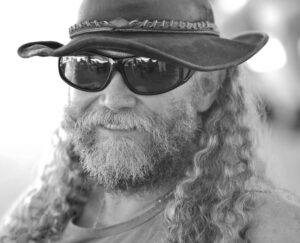History of Hapkido
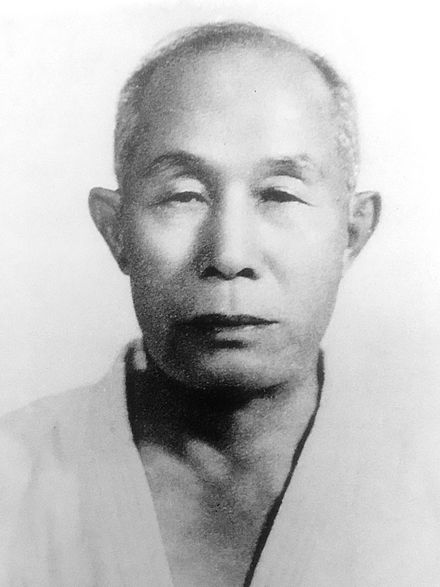
Welcome to the History of Hapkido. So in undertaking the task of writing a historical perspective of Hapkido. I am fully aware of the fact that it is, in all likelihood, an exercise in futility.
I say this because with the exception of a few (Choi Yong Sool and Myung Jae Nam and Bong Soo Han). Also the majority of the personalities who shaped the landscape of Hapkido are still alive.
Yet, a single common and consistent version of the history of Hapkido does not exist.
History of Hapkido
Therefore one would think that all of the key figures in the History of Hapkido would come together. And agree on one version to be promulgated for future generations of practitioners.
Instead, they put forward a history based on ethnocentrism, national prejudice, and personal and political agendas. And are all vastly different from the other.
History of Hapkido
They are Choi Yong Sool (Yawara/Dae Dong Ryu Hap Ki Yu Sool), Suh Bok Sup (Yawara/Dae Dong Ryu Hap Ki Yu Sool), Ji Han Jae (Modern Hapkido/Sin Moo Hapkido), Kim Moo Woong (Hapkido Shin Moo Kwan), Suh In Hyuk (Kuk Sool Won – Hapkido), Suh (Seo) In Sun (Kuk Sool Hapkido), Joo Bang Lee (Hwa Rang Do-Hapkido), Kim Jung Yoon (Han Pul) and Won Wha Kwang (Hapkido Moo Sul Kwan), Sea Oh Choi, Kwang Sik Myung and Bong Soo Han.
Most of all while there are a small number of facts that have been consistent. And there are an exponentially greater number of facts that are half truths, lies, and embellishments. Thus making the history of Hapkido hard to trace.
History of Hapkido
Very importantly gone are the days when practitioners would simply just practice a martial art without questioning the validity of that art. And it was enough just to be given the opportunity to be a part of the Asian mysticism. Our Asian counterparts knew this and capitalized on it. Hence practitioners are now more curious. They have become discerning, asking questions that were never asked before.
Therefore as a result, the inconsistencies, half-truths, and lies have become painfully obvious. Hence, the need for a consistent account of the last sixty years of Korean martial art history is needed. This is a common tread in all Korean systems I have looked at thus far.
I know I will not be able to accomplish that here. However, I can certainly begin the process or at least shed some light on this quagmire of varying and often conflicting historical facts. The construction of this history of Hapkido is based on currently available written sources. I will interject personal commentary where I feel it’s warranted.
Also because it may help a discerning mind to separate the fact from fiction. Most of all in the end, it is up to each individual to decide what the truth is with regard to the History of Hapkido.
History of Hapkido - Popular Martial Art
Regardless of its convoluted history and controversy, Hapkido has become one of the most popular martial arts of the 21st Century. This is due to both positive and negative circumstances. Because Hapkido, as some would think, is devoid of signature skills. This has caused variations and eclectic styles to emerge.
And that these variations are often nothing more than a patchwork of poorly conceived skills. However this is not always true either. Many great eclectic styles have been founded off Hapkido. These add to the richness of the History of Hapkido.
The above combined with inflated ranks, has led to the art having a less than desirable reputation in the world martial arts community. Many deserve the ranks they have. Please do not get me wrong. However many other have nothing to earn these high ranks. However, amidst the controversies, key individuals such as Ji Han Jae and others have managed to move the art forward. Thus it is a force to be reckoned with.
I will limit my discussion to Choi Yong Sul, Ji Han Jae, Suh In Huyk, Suh (Seo) In Sun, Joo Bang Lee, Joo Sang Lee. But, there were others such as Kin Moo Hyun (Woong), Kim Jong Yun and Woong Wha Kwon. And their who who's contribution to the early development of Hapkido. These should not be minimized in any way. And therefore, deserves equal time. LetȚ continue now with more of the History of Hapkido.
History of Hapkido - Choi Yong Sul (1904-1986), Father of Hapkido:
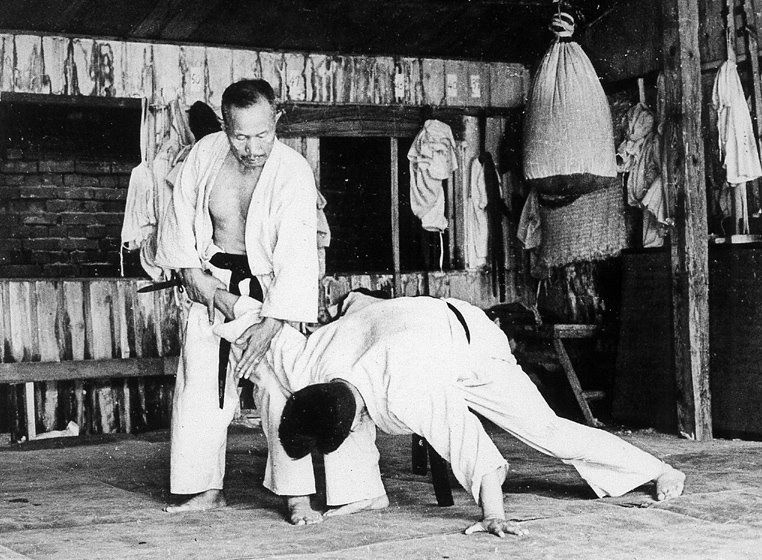
This is important to the History of Hapkido. So, from what I can ascertain and what appears to be the most consistent fact is that the genesis of Hapkido is Choi Yong Sool. From all accounts Choi was born in Chung Bok province, South Korea. Supposedly and according to most accounts, Choi’s family was very poor. And they lived near a candy factory owned and operated by a Japanese couple, the Morimoto’s.
Apparently, the couple took a liking to young Choi. And since his parents could not afford to raise him, they allowed them to take him to Japan. Choi was around nine years old at that time. It would not have been a problem for the Morimoto’s to take Choi to Japan. This was easy since after all, they were Japanese nationals and he was a subject.
Another account states that Choi was kidnapped by Morimoto’s. At any rate, after arriving in Japan the couple left Choi at a Buddhist temple. This was because they wanted to travel and did not wish to be hampered by him. As you can see right off the bat we have conflicting information.
History of Hapkido - Other accounts
Other accounts states that Choi was left at the temple in order to receive an education. This little detail does not make much sense. Why would the Japanese couple who supposedly took a liking to Choi take him Japan only to leave him at a Buddhist temple?? Thus never to be seen again? That seems somewhat extreme and non nonsensical. Choi was expelled from the temple because he was not interested in an education, lacked discipline, and was disruptive.
Therefore it is difficult to imagine that the authorities of the temple would orphan a young Korean boy in a strange land. Other accounts states that the Morimoto’s abandoned Choi shortly after arriving in Moji, Japan because he was difficult to handle. Nevertheless, a monk at the temple, Kintaro Watanabi, gave Choi to his friend for care.
History of Hapkido - Sokaku Takeda (1859-1946)
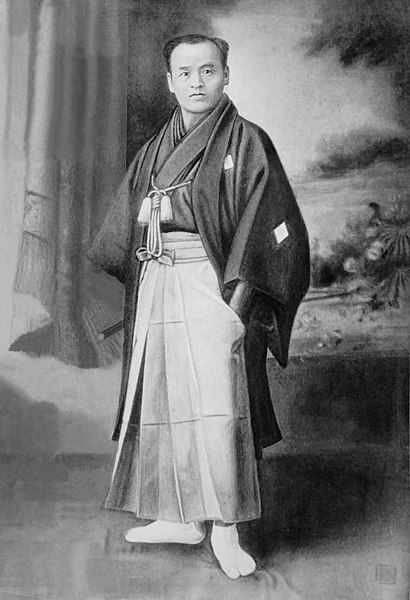
Choi supposedly worked as a house boy and Dojo caretaker before being permitted to study Daito Ryu (Great Eastern School). This anecdote cannot possibly be accurate because Takeda never really owned a Dojo.
Further, he spent very little time with his own family. This is because he was too busy traveling around the country teaching and testing his skills.
There were periods, usually no more than a one year at a time, when he was housed with his most famous student, Morihei Ueshiba (1883-1969). Ueshiba was the founder of Aikido.
It is likely that Choi was an employee or manservant of Takeda. And given the socio-political circumstance of times but, certainly not his adopted son. Interviews of Tokimune Takeda (1916 – 1993), son of Takeda who inherited his legacy and Kisshomaru Ueshiba (1921 – 1991). And son Ueshiba and second Doshu of Aikido conducted by Standly Pranin, Editor of the Aikido Journal. This yielded virtually no corroboration of Choi’s claims.
Aikido Journal
Neither of them remember him specifically. They both stated that they recall Takeda conducting seminars in which a Korean or small group of Koreans participated.
There were units of the Sendai army, Sendai, Japan that were made up of Koreans. Choi is known to have conducted seminars for the Sendai army. Takeda was known to maintain meticulous records (Eimeiruku) of everyone he taught even at seminars.
According to Stanly Pranin and others, a review of Takeda’s Eimeiruku yielded negative results. There weren’t a single entry of Choi ever having studied with him. Chong Bae Rim of Rim’s Hapkido asserts that some of Takeda’s records were burned in a fire.
And that to acknowledge him in his Eimeiruku would undermine the Japanese character of Daito Ryu. This assertion by Rim is contradictory given that there was at least one Korean that we know of listed in Takeda’s Eimeiruku. And of this making the history of Hapkido hard to verify completely.
More History of Hapkido, so keep reading!
History of Hapkido - Questionable History of Hapkido
Therefore if Choi was a part of Takeda’s life to the extent that Choi purported, someone would have remembered him.
And perhaps the biggest factor that refutes Choi’s claims is that Takeda was known as a staunch Japanese nationalist.
Takeda had a preference for teaching government and high ranking military officials. Others had to be by formal introduction and recommendation. This was the case of Ueshiba who was introduced to Takeda by Kotaro Yoshida (1883 – 1966). Yoshida was somewhat of a controversial figure during his time. He was a journalist and a member of the Black Dragon Society. Which is a right wing political group. And he was also considered an intellectual and very liberal in his views.
I have found it curious that Choi’s Japanese name was Yoshida. Further, It has been speculated that Yoshida was actually Choi’s teacher. In any case, Choi’s Japanese name was supposedly Yoshida Asao (Tatsujutsu/Tatujutu). And even this name is problematic from a Japanese cultural point of view.
History of Hapkido - Challenge
No one else but Kotaro Yoshida would have accepted a challenge such as this given his views. It was not uncommon for a practitioner like Choi to claim that his teacher was Takeda when it was in fact Yoshida provided they share the same lineage. Another case and point is Jang In Mok (1912 – ), the only Korean, thus far, to have a provable lineage to Daito Ryu.
Jang’s teacher was Toshimi (Hosaku) Matsuda, a student of Takeda. Matsuda was known to have several Koreans under his tutelage. Apparently, Jang taught very little and focused more on his profession as a Doctor of Traditional Chinese Medicine.
History of Hapkido
In an interview Choi gave during his visit to the United States in June, 1982, he stated that Takeda committed suicide by starving himself to death. This was in protest of Japan loosing the war. And according to his son, Tokimune, Takeda died unexpectedly of a stroke while teaching in Aomori, Hokkaido in 1943.
Choi asserted that Takeda died of a stroke secondary to malnutrition. This was before the war ended so Takeda would not have known of its outcome. Following Takeda death, Choi returned to South Korea sometime in 1945. Popular lore has it that he lost (or it was stolen) his luggage containing personal items. And also documents of his martial arts training while in Japan at a (Yong Sun) train station in his home town of Yong Dong.
History of Hapkido - Choi
This incident may have actually occurred but again, it is unsubstantiated. When one considers the totality of the circumstances with respect to authenticity (or lack thereof) of Choi’s claims, this story is consistent. At any rate, after this incident Choi decided to settle in Daegu City.
During a personal interview of Suh Bok Sup in April, 2004, he reiterated this story. Although, there was the feeling that he was repeating what was told to him and not responding from personal knowledge. Upon arriving in South Korea, Choi supported himself by selling rice cakes until he had accumulated enough money to purchase a few pigs.
History of Hapkido continues
Choi was illiterate and from everything learned from those who trained directly under him, rough around the edges.
There is also a general perception and sentiment that he was driven by money. He charged exorbitant fees for instruction and demanded a lot from his students. Therefore, only a few were afforded the privilege of his time and energy. This was confirmed in the course of personal conversations with Ji Han Jae, Doju.
When Choi made a historic visit to the United States in 1982. This was in an effort to bring together all of the Hapkido factions. Therefore Choi appointed Chin Il Chang as his successor. And he hoped that he would be able to fulfill his hope. However, Chang was not at all interested in such a responsibility and so Choi’s plan failed. Choi died in 1986 at the age of 82 and was buried in Taegu, South Korea.
History of Hapkido - Suh Bok Sup(1906 – Present), First Hapkido Dan Holder
Approximately three years after arriving in Daegu, on February 21, 1948, Choi met his first Korean student, Suh Bok Sup. And at the time of their meeting Suh was an attorney, a Judo 1st Dan. And a student of Yong Ho Choi, manager of a Makju (Korean wine) brewery owned by his father, Suh Dong Jin.
On the day in question, Choi came to the brewery to secure chaff (grain) left over from the brewing process. When a group of people who there for the same purpose tried to take his place in line, a fight ensued. Choi was able to manage his attackers with relative ease. This incident was witnessed by Suh who was observing from the second floor office loft of the brewery.
Suh hurried down to intercept Choi before he left. This was because he was impressed by the unusual martial arts skill displayed by him. Suh brought Choi back to his office at the brewery where he had Judo Tatami’s (mats) arranged for practice. When Suh inquired about what kind of martial art Choi was doing, he invited him to attack him. When he did, he was deftly defeated. In return for instruction, Suh provided Choi with free chaff and payment for his lessons.
The History of Hapkido is so very rich!
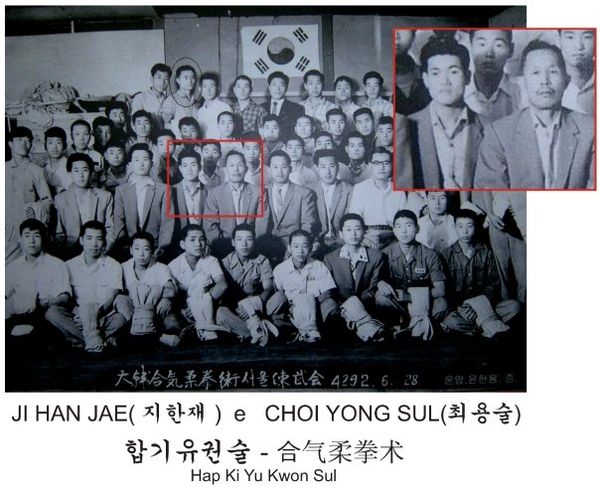
History of Hapkido - 1st Lesson
Suh first lesson was supposedly the next day. Therefore Suh became the first Korean to achieve Dan ranking in what Choi was calling Yawara which can be roughly translated as wrestling. What Choi taught went through several name changes such as Dae Dong Ryu Hapki Yu Kwon Sool, Yu Kwon Sool, Yu Sool, and eventually, Hapkido. The name Dae Dong Ryu Hapki Yu Sool is a transliteration of Daito Ryu Aiki Jujutsu (Great Eastern School/Style of Harmonious Energy Soft Skills).
This was what Choi supposedly learned from his mentor, Takeda.
On February 12, 1951, three years after their initial meeting. Suh now a 1st Dan and Choi opened their first public school naming it Dae Han Yu Kwon Sool Hapki Dojang (Korean Soft Fist Style Coordinating Energy School). Suh’s influence on the development of Hapkido can be seen in the wide variety of clothing seizures and defenses against throws.
History of Hapkido - Students
Some of Choi’s early and most influential students includes, Ji Han Jae (began in 1949), Mu Hyun (Woong) Kim, Joo Bang Lee, Joo Sang Lee, Suh, In Hyuk, Seo, Kim Jong Yong, Won Wha Kwang and others. There are other anecdotal events that took place involving Suh but, in my opinion, they are not historically relevant.
In a personal interview with Suh during a trip sponsored by Grandmaster Suh (Seo) In Sun, World Kido Federation, in April 2000, he stated that the name “Hapkido” was first used by he and Choi in 1958. When questioned about the validity of Ji Han Jae’s claim that he was the first to use the name, he simply stated that that is how he remembered it.
Conversations with Suh Bok Sup was about Traditional Chinese Medicine and Chiropractic. He seemed more interested in these two subjects than he was about the early history of Hapkido.
History of Hapkido - Ji Han Jae (1936 - ), Founder of Modern Hapkido
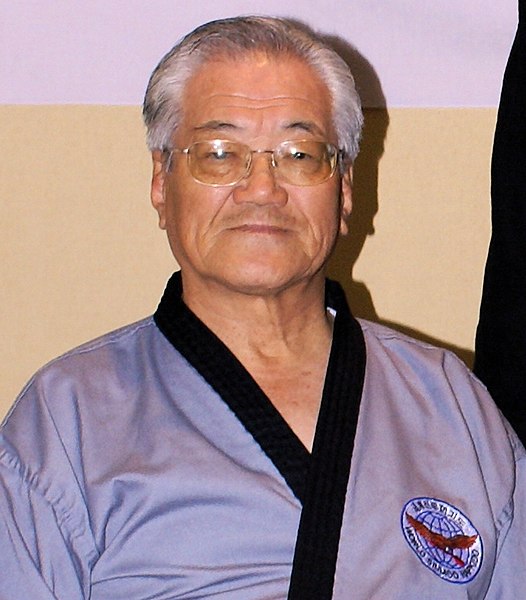
History of Hapkido: Ji Han Jae was born in Andong Province, South Korea. He began training under Choi in 1949 at age 13 in Seoul, South Korea. And Ji studied continuously (for 7 years) with Choi until 1956. Importantly Ji also supposedly trained with a Taoist master named Lee from whom he studied Taek Kyun. Also long and short staff and meditation practices.
He concurrently trained with a Buddhist nun who he refers to as “Grandma.” It was from whom he learned meditation and other spiritual development practices. The actual existence of Taoist Lee and “Grandma” as of this writing has not been independently verified.
History of Hapkido - Name of Hapkido
In private conversations Ji, he spoke of also studying Sam Nang Do (Supposedly a group similar to the Hwa Rang of Silla).
He would talk of the fact that he was the first to use the name Hapkido to represent his version of what Choi taught.
Further, he has also been emphatic about being the one to add kicking, the Dan Bong (Short Stick), Jang Bong (Long Staff), Ji Pang Ee Sool (Walking Cane Skills) and Po Bak Sool (Rope Skills) to the Hapkido Curriculum.
Therefore he made specific reference to the spin kick. This of which in his view, should only be executed with the right leg with the contra-lateral palm touching the floor.
Not once has he ever mentioned Kim Moo Hyun (Woong), a fellow student of Choi and good friend of Ji’s. Who most believe to be the true innovator of kicking in Hapkido. Hyun (Woong) apparently studied Taek Kyun extensively. Most likely this was due to the fact that Hyun (Woong) spent approximately nine months at Ji’s dojang (Song Mu Kwan) in Seoul.
History of Hapkido - More on Ji
Ji, at the rank of 3rd Dan, opened his first school, the An Moo Kwan, in home town, Andong in 1957. It was here at which he taught Yu Kwon Sool. Nine months later, he relocated to Seoul where he founded the Song Mu Kwan.
Apparently Ji began organize all he had learned into a rational curriculum and first called it Hapki Yu Kwon Sool.
However, in retrospect, he thought the name was too long. In 1959, he changed the name to Hapkido. This curriculum devised by Ji is, for the most part, the same one with variations promulgated by most Hapkido schools and organizations.
There is controversy as to who coined and adopted the use of the name, Hapkido. Some say it was Choi while others say it was Ji. Regardless of who it was, Ji is credited with being the founder of modern Hapkido. Ji and his students almost single-handedly spread the art worldwide. Also Ji and his Hapkido Song Mu Kwan rose to prominence in the Korean Martial Arts community. Thereby Ji was able to secure a teaching position instructing the military supreme council and as instructor to the President’s (Park Jung Hee) security forces. He held this position until Park’s death in 1979. Let's continue the History of Hapkido journey.
More History of Hapkido
In 1963, Ji, along with his teacher Choi Yong Sul, and classmates, Suh Bok Sup, Joo Bang Lee, Joo Sang Lee Woo Tak Kim, Jong Yun Kim, Kwang Hwa Won. And also possibly Suh In Hyuk and Suh (Seo), held a meeting at Jong Yun Kim’s (Han Pul) dojang. And here decided to adopt the name “Kido” to represent what was previously called Hapkido.
Their rationale for this change was that the name “Hapkido” was too similar to the martial art founded by Moreihi Ueshiba and therefore, chose a name (Kido) to distinguish it. So they formed the Han Kuk Kido Hae to serve as the public face of this newly formed alliance.
On September 2, 1963, Han Kuk Kido Hae received a charter from the Korean Ministry of Education. This charter granted Han Kuk Kido Hae the authority to regulate standards and promotion requirements for Hapkido. Including thirty-one other martial art styles that were not subsumed under the Taekwondo movement.
History of Hapkido - Lee Kyu Jin
Lee Kyu Jin (Kim Kyung Dong) was elected as it’s president and Kim Jong Yun was appointed as secretary general. And Lee served for two terms and was replaced by Kim Kyung Dong who served for several terms. On January 26, 1978, at the eighth election, Choi Byung Rin was elected president. Plus on April 5, 1981, at the ninth election, Pyo Si Chan was elected president.
And on June 1, 1983 at the tenth election, Suh (Seo) In Hyuk was elected president. Suh (Seo) was the first martial arts master to be elected as president, all previous elected presidents were “politicians”. And as history has always proven politics leads to propaganda and misinformation like we see in the history of Hapkido. I has approached the son of my Korean Grand Master for information. However he never responded to my request. Grand Master Oh's help could have clearedmuch of this information up. And brought truth to light.
History of Hapkido - Changes
In 1965, Ji and his group of masters (Song Mu Kwan) did not agree with the direction the Han Kuk Kido Hae was taking and withdrew. He formed the Dae Han Hapkido Hae (Korea Hapkido Association). This association was formed with the blessing of the then South Korean President, Park Jung Hee.
In 1973, Ji resigned from the Dae Han Hapkido Hae along with Kim Moo Hyun (Woong) and Myung Jae Nam and formed the Dae Han Hapkido Hyub Hae (The Republic of Korea Hapkido Federation). Ji was the first to leave the federation followed by Myung Jae Nam who eventually left this organization.
When Ji left the KHF he reclaimed use of the name, The Korea Hapkido Association. (KHA). The remaining members of the original KHF had also adopted use of the name, KHA so there was conflict. In 1988 a new organization, the Korea Hapkido Federation (KHF) emerged out of this tumultuous time. A student of Ji, Oh Se Lim was elected as president. Lim has remained president since its inception. The KHF is the largest governing body for Hapkido in the world. I had once approached this organization for membership. The costs were very high.
On May 27, 1968 Ji at age 32, 11 years after his promotion to 3rd Dan, along with Joo Bang Lee, was promoted to the 8th Dan by Choi Yong Sul. I mention this to make a very obvious point. I hope the reader have some clue where I am going with this.
History of Hapkido - Politics is always the reason for corruption
And Ji, due to his political connections was appointed as Chief Hapkido instructor for the President’s Security forces and had become influential. Hence his influence allowed him to operate his own Hapkido organization (Korea Hapkido Association) without interference.
However Ji’s influence came to an end when President Park Jung Hee regime came to an end in 1984 when he was assassinated. Therefore Ji spent one year in jail as a political prisoner due to his association with President Park’s assassin, Kim Chae Kyu.
Kim was the head of the South Korean CIA and a student of Ji. During his time in jail, Ji formulated the concepts and principles which were to become Sin Moo Hapkido. Sin Moo Hapkido focuses more on spiritual development and quality of life practices.
History of Hapkido - Move to the USA
In 1984, he migrated to Germany and then to United States where he founded Sin Moo Hapkido (Higher Mind Martial Art Way of Harmonizing Energy). Also Ji currently heads the loosely organized World Sin Moo Hapkido Association (WSMHA). Where membership in the WSMHA is by Dan rank holding only.
Other than Dan certification fees and fees generated from workshops and seminars. There is no other stream of income to maintain association activities. This is mostly due to Ji’s reluctance have a more formal organizational structure.
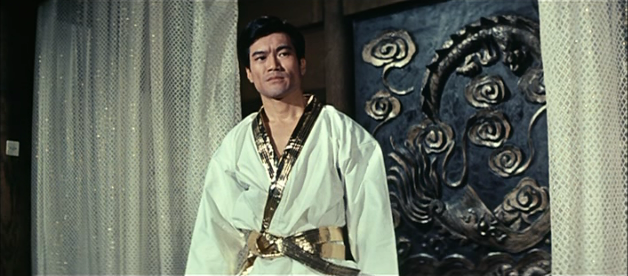
History of Hapkido Kuk Sa Nim Ji's Influences
And Ji had a huge influence in martial arts movie industry. He appeared as a lead in the movie Hapkido aka, Lady Kung Fu with Angela Mao Ying, Cater Wong, Samo Hung, and Hwang In Shik. These individuals were also his students.
He appeared in the Game of Death with Bruce Lee. Ji was the fighter in gold belt in the movie.
History of Hapkido - Hapkido Students
Ji had number of students who themselves had a tremendous impact on the spread of Hapkido worldwide. They include:
- Kwang Sik Myung, current president of the World Hapkido Federation,
- the late Bong Soo Han, president of the International Hapkido Federation,
- Oh Se Lim, current president of the Korea Hapkido Federation,
- the late Myung Jae Nam, president of the International Hapkido Federation ,
- and Sea Oh Choi (status unknown), who formally introduced Hapkido to the United States.
Most of the current senior practitioners of Hapkido are former students of Ji. However, many of them do not acknowledge him as their teacher. This is because they feel that he was in some way responsible for President Park’s assassination. And therefore, claim Choi as their teacher or completely fabricate their Hapkido histories. This is very however very similar to those who renounced James M Mitose of Kosho Shorei Ryu Kempo.
In my opinion Ji should be considered the “founder” of Hapkido as we know it today. Choi on the other hand should be considered the “father” of Hapkido. Ji transformed what he learned from Choi. He (with Kim Moo Hyun (Woong) added the extensive kicking arsenal, striking, and a variety of weapons (short stick, long staff, cane, rope etc,).
History of Hapkido - Ji the founder
Plus Ji also organized Hapkido skills into a comprehensive curriculum which is observed by eighty percent of Hapkido practitioners worldwide with variations. Seventy to eighty percent of the main schools of Hapkido can be traced back to Ji. Choi actually directly taught very few people because he charged very high tuition fees and the training was severe. As of this writing, I have spent numerous hours with Doju Ji.
Some of this time is spent helping him handle personal business and others were spent in deep discussion about the true nature of Hapkido. He feels that the physical and technical aspect of Hapkido represents only twenty percent of the art. The remaining eighty percent is on spiritual and mental development and on productive lifestyle practices.
This statement I agree with personally.
History of Hapkido - Suh In Hyuk, Suh (Seo) In Sun & Kuk Sool Won- Hapkido
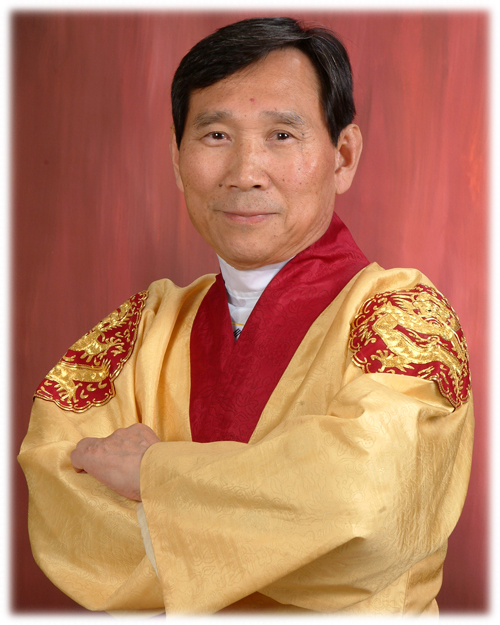
Suh In Hyuk and Suh (Seo) In Sun was front and center during the formative years of Hapkido. Both were students of Choi Yong Sul. Seo In Sun was granted the 1st Dan in 1958. It is unknown at this time exactly Suh In Hyuk was granted Dan status. But it is safe to assume that it was at the same time Seo In Sun.
I know of someone with a personal relationship with Seo In Sun for many years. Most importantly he has always been forthcoming with the fact that Choi Yong Sul was his teacher. His older brother, Suh In Sun who I also had a very close relationship with during 1980s, was not as forthcoming. He does not acknowledge being a student of Choi.
History of Hapkido - Suh In Hyuk
Further, he does not acknowledge monks Tae Eiu Wang and Dong Hae as his teachers. Instead he promulgates a martial arts history that talks about him beginning training under his Grandfather. I don’t see how this would have been possible because according to his brother.
History of Hapkido - Kul Sool Won Hapkido
According Seo In Sun, Suh Myung Duk died when Suh In Hyuk was around six years old. Seo In Sun intimated he never saw any training going between Suh Myung Duk and Suh In Hyuk.
It is common knowledge that the Suh brothers also studied Southern Praying Mantis. And also what is referred to as Ship Pal Gi (18 Weapon skill). Both of these disciplines are Chinese influenced. They studied under monks Tae Eui Wang and Dong Hae.
In my opinion, the Suh brothers took what they learned from Choi, Ji Han Jae and others and combined it with their Chinese influenced arts to create what was known as Kuk Sool Hapkido. Suh In Hyuk claim to have founded Kuk Sool Won in 1958. That would make him twenty years old at that time.
History of Hapkido
Regardless, it is well known that Suh In Hyuk had relationship with Choi Yong Sul, Ji Han Jae, Moo Hyun (Woong) Kim, Joo Bang Lee. Moreover, the skills that comprise the Kuk Sool Won curriculum are identical to the ones shared by Hapkido practitioners worldwide.
Suh (Seo) In Sun is currently diligently working to create an environment of cooperation with all of the major Hapkido organizations and to correct the fractured history of Hapkido.
History of Hapkido - Joo Bang Lee, Joo Sang Lee & Hwa Rang Do (Hapkido)

Joo Bang Lee (1936 – ) and his brother, Joo Sang Lee (1937 – ) were both early students of Choi Yong Sul. They were also known to have studied with Kim Moo Hyun (Woong), Suh In Hyuk, and Ji Han Jae. Joo Bang Lee maintains that he was trained from age 4 by Suam Dosa, the 57th lineage holder of the Hwa Rang tradition.
And Joo Bang Lee further maintains that the aforementioned individuals were not his teachers in any capacity. But were colleagues with whom he collaborated. None of this is plausible for many reasons. Not the least of which that Suam Dosa could not have represented the ancient Hwa Rang.
Hwarang Kwan
Any evidence, not withstanding historical references and artifacts are scarce. And also practically nonexistent, much less, an intact martial discipline. Joo Bang Lee founded the Hwarang Kwan, a school of Hapkido in 1962.
This Kwan later became “Hwa Rang Do” in 1972 shortly after his arrival in the United States. The Kuk Sool Won (Hapkido) and the Hwa Rang Do (Hapkido) curriculum bare a striking resemblance. So it’s either Suh In Hyuk studied under Joo Bang Lee or vice versa. Regardless, it is obvious that they both share similar training experience.
Suh In Hyuk has stated directly during one of his visits to my school in the mid-eighties that Joo Bang Lee was his student. Regarding who was the first to use the name “Hapkido” Joo Bang Lee stated on the World Hwarando Association official website that. “originally, in 1959, one of his friends, Master Moon Kang opened a school in Taegu with the name Hapkido for the first time."
History of Hapkido - More about Hwa Rang Do
However, six months later, master Choi ordered that the school be closed down because he did not want the “Yu Sool” name to be switched to the Hapkido name. Master Kang then moved the school to Seoul to work for the DEA and Dr. Lee got the idea of this new martial name from master Kang.
Also, in 1961, Yu Sool masters Han –Jae Ji and Mu (Woong) Kim began using this Hapkido name as well. Because of the circumstances surrounding the Japanese Occupuation. The Korean Public Hated to use Japanese language during this time. So master Choi’s first masters did not want to use the “Yawara (Yu Sool)” name for their dojangs.”
According to Bob Duggan an early student of Joo Sang Lee and then Joo Bang Lee, Joo Bang Lee once intimated to him that he did study hand (striking) skills from Suh In Hyuk for a short time. I encourage readers to visit Duggan’s website.
He gives a first-hand personal account of his experiences with Joo Sang Lee, Joo Bang Lee and what eventually became Hwa Rang Do.
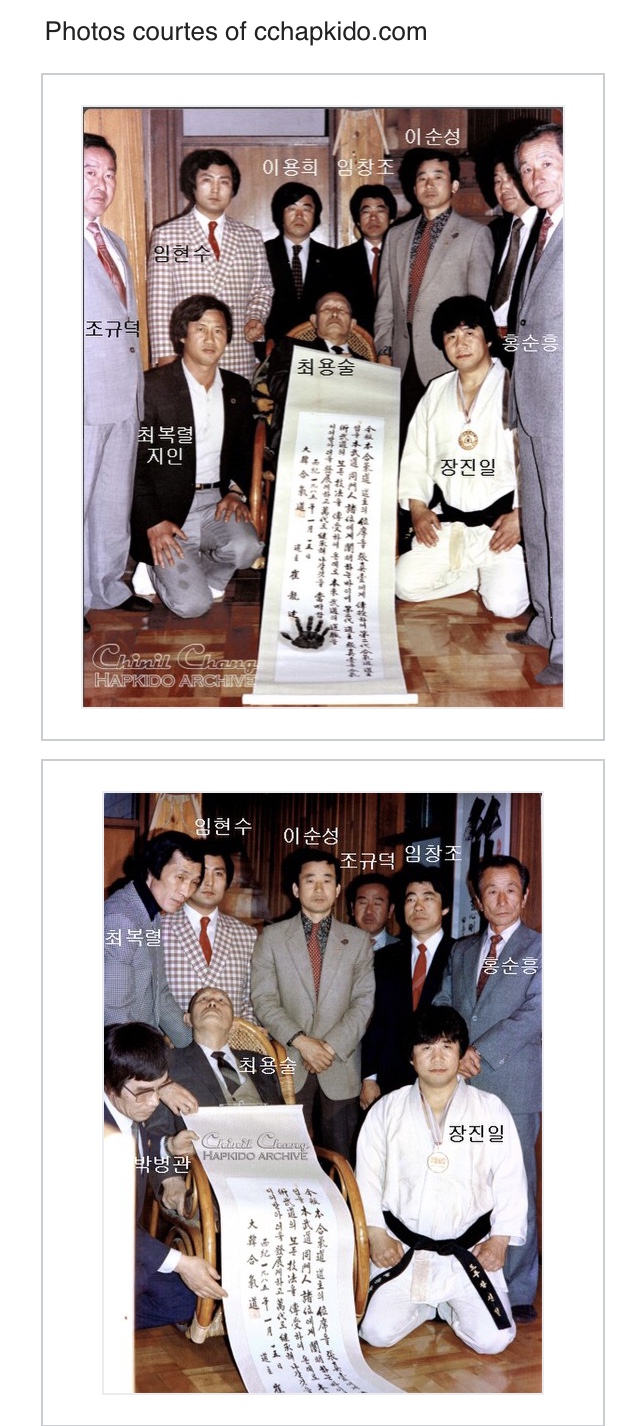
History of Hapkido References
Hapkido is rendered "합기도" in the native Korean writing system known as hangul, the script used most widely in modern Korea.
The art's name can also however be written "合氣道". This is utilizing the same traditional Chinese characters which would have been used to refer to the Japanese martial art of Aikido. Used in the pre-1946 period.
The current preference in Japan is for the use of a modern simplified second character; substituting 気 for the earlier, more complex character 氣.
The character 合 hap means "coordinated", "joining", or "harmony"; 氣 ki literally means air, gas or breath but is used to mean spirit or 'internal energy'; and 道 do means "way" or "art", yielding a literal translation of "joining-energy-way".
It is most often translated as "the way of coordinating energy", "the way of coordinated power", or "the way of harmony".
Although Japanese Aikido and Korean Hapkido share common technical origins. In time they have become separate and distinct from one another.
They differ significantly in philosophy, range of responses, and manner of executing techniques.
The fact that they share the same Japanese technical ancestry represented by their respective founders practice of Daitō-ryū Aiki-jūjutsu.
And that they share the same Chinese characters, despite 合 being pronounced "ai" in Japanese and "hap" in Korean. This has proved problematic in promoting Hapkido internationally. It is as a discipline with its own set of unique characteristics differing from those common to Japanese martial arts.
History of Hapkido researched by Sensei Kara Borshuk.
History of Hapkido - Other Influential Martial Artists.
The history of Hapkido would not be complete without addressing others of influence to the art in the west.
Grand Master Scott Shaw
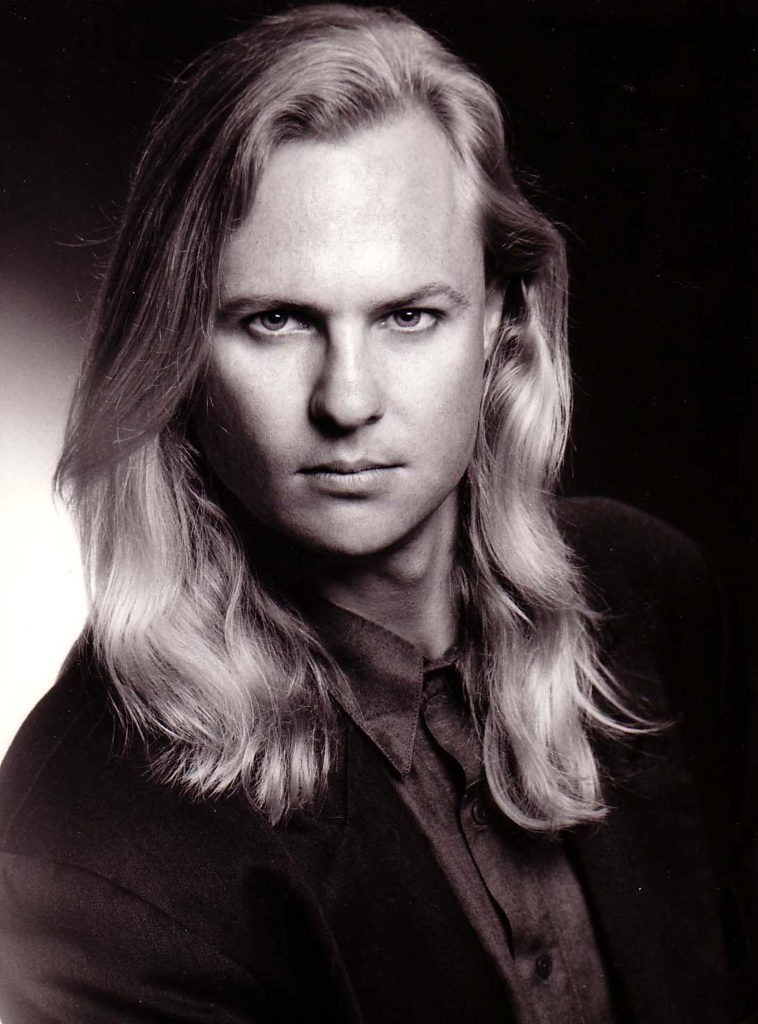
Hapkido Master Scott Shaw has become one of the most prolific voices of the modern American Martial Arts. Articles he has written over the years for journals such as BLACK BELT, MARTIAL ARTS SPORTS & COMBAT, INSIDE KARATE, INSIDE TAEKWONDO and TAEKWONDO TIMES. These have explored many of the subtle elements of self-defense previously only revealed to advanced students in the arts.
Articles
In addition to being a journalist, Shaw has authored a number of books that have instigated new realms of understanding in the modern Martial Arts. These texts include: HAPKIDO: THE KOREAN ART OF SELF DEFENSE, THE KI PROCESS: KOREAN SECRETS FOR CULTIVATING DYNAMIC ENERGY, THE WARRIOR IS SILENT: MARTIAL ARTS AND THE SPIRITUAL PATH, SAMURAI ZEN, and THE TAO OF SELF DEFENSE. I have personally read several of his books. With his extensive list of published works, in addition to a HAPKIDO VIDEO TAPE SERIES produced by Unique Publications,
it is very interesting to peer into the foundational experiences which led to Scott Shaw becoming such a sought after proponents of the modern Martial Arts. Master Shaw is also a very approachable man.
History of Hapkido - The Early Years
It was an ironic set of occurrence that first exposed Shaw to formal training in the Martial arts. During the 1960’s, by the age of six. At this young age Shaw had already developed a deep fascination with the Martial Arts. He had learned some basic movements from his father. His fathers was as a World War II veteran had been trained in jujitsu and hand-to-hand combat. One day, while Shaw was practicing his youthful techniques in his backyard, the new gardener took notice of his actions.
The gentleman explained to Shaw’s parents that he was newly relocated from Tae Gu, Korea. He also added he was a Black Belt in a Martial Art System then known as Ho Shin Moo Do. This is the style which later became Hapkido. With this, Shaw had his first instructor and he began his path of formalized training.
Shaw spent the first decade of his life in South Central Los Angeles and his adolescence in East Hollywood. From these gritty street environments he came to readily understand the level of unnecessary violence that is prevalent in many urban centers. Whereas these unforgiving surroundings have sent many a youth down a road to destruction. Shaw saw it as a pathway to the development of inner strength and self-reliance. With Martial Arts as a central focus, Shaw rose above the limitations of his youthful atmosphere. And now he possesses over fifty years experience in the Martial Arts.
History of Hapkido - Traveling to the Source
In the 1970’s, with graduation from Hollywood High School behind him, Shaw began to journey to Asia. He did this not only to refine his Martial Art skills but to delve into the meditative sciences. Of which he had become deeply involved in as a teenager. His first destination was India where he lived in the small Himalayas town of Rishikesh. There he studied and taught the physical and the meditative aspects of yoga. His second destination was Kyoto, Japan. This is where he not only further refined his meditative understanding. But he became deeply involved with the science of Ki. Shaw would later make these understandings essential elements to his Martial Art teachings.
When asked why more Western Martial Art Instructors do not teach meditation and Ki, Shaw states, “I believe it’s because in the Western world we are so dominated by immediacy. No one is willing to sit down and really learn how to focus their mind to the degree which is required in meditation and Ki Gong. In American everybody wants recognition for their accomplishments: a high belt, a new title, or whatever. In meditation there’s no external reward for your advancement. So, most Martial Artists blow it off, believing that it’s just not important to their overall development. They’re wrong.”
History of Hapkido - Master Shaw
Shaw eventually returned to United States to attend college. By this point he already held advanced Black Belts in Hapkido and Taekwondo. He then began teaching the Martial Arts on a full time basis. Upon the completion of his Bachelors Degree he began to frequently return to South Korea. This was to further refine his understanding of the Korean Martial Arts.
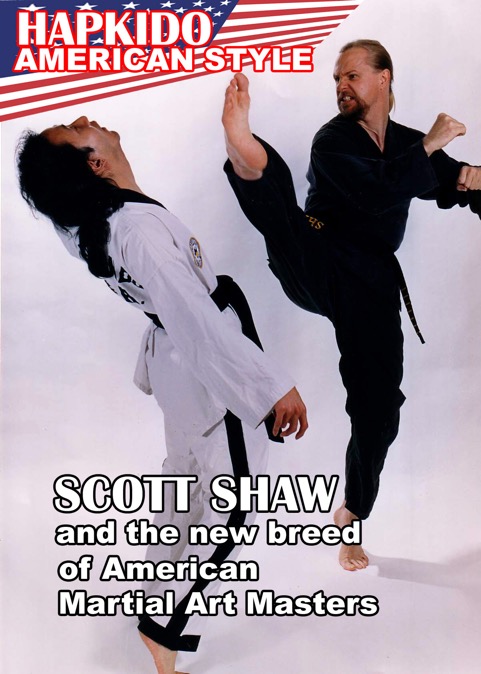
In Korea, Shaw studied under some of the first generation Masters of these modern Korean Martial Arts. The knowledge passed onto him during this period has allowed him a unique perspective.
This perspective to not only teach the Martial Arts with authority but to look deeply into the ideologies and fundamentals. Of which actually formed the foundations for the modern Korean Martial.
The question is often asked of Shaw, “What is the difference between Martial Art training in the West and the training which takes place in South Korea?” He answers, “Mostly, it's the overall level of intensity which both the students and the instructors possess in Korea.
The American Martial Art mindset is very lackadaisical in comparison to the Korean. Instructors here are not allowed to truly motivate their students when they are slacking off by yelling at them or striking them with a bamboo shaft which is commonly done in Korea. Though certainly some great Martial Artists have risen out of America — most, however, do not posses the ‘Never-say-die’ attitude which is present in virtually all Korean trained practitioners.”
History of Hapkido - Hapkido Verses Taekwondo
Possessing Master Instructor Certifications from Korea in both Hapkido and Taekwondo, Shaw holds unique insight into the differing factors inherent in these two arts. “Hapkido and Taekwondo are two completely different systems of self defense,”
Shaw exclaims. “Taekwondo is a very linear, get in your face style of Martial Arts, where Hapkido is just the opposite — it’s based in meeting forceful energy with deflection.” He goes on to detail, “As is the case with all modern Korean Martial Arts, they were created by individuals who were trained, to varying degrees, in the Japanese arts which were prevalent during Japan's annexation over Korea. The origin of Hapkido is based in Diato Ryu Aikijutsu and Taekwondo was largely influenced by Karate — though most Taekwondo stylists wish to deny this fact. These are two very different art forms. From these points of inception, Hapkido and Taekwondo have evolved very differently.”
History of Hapkido - History Leads to the Future
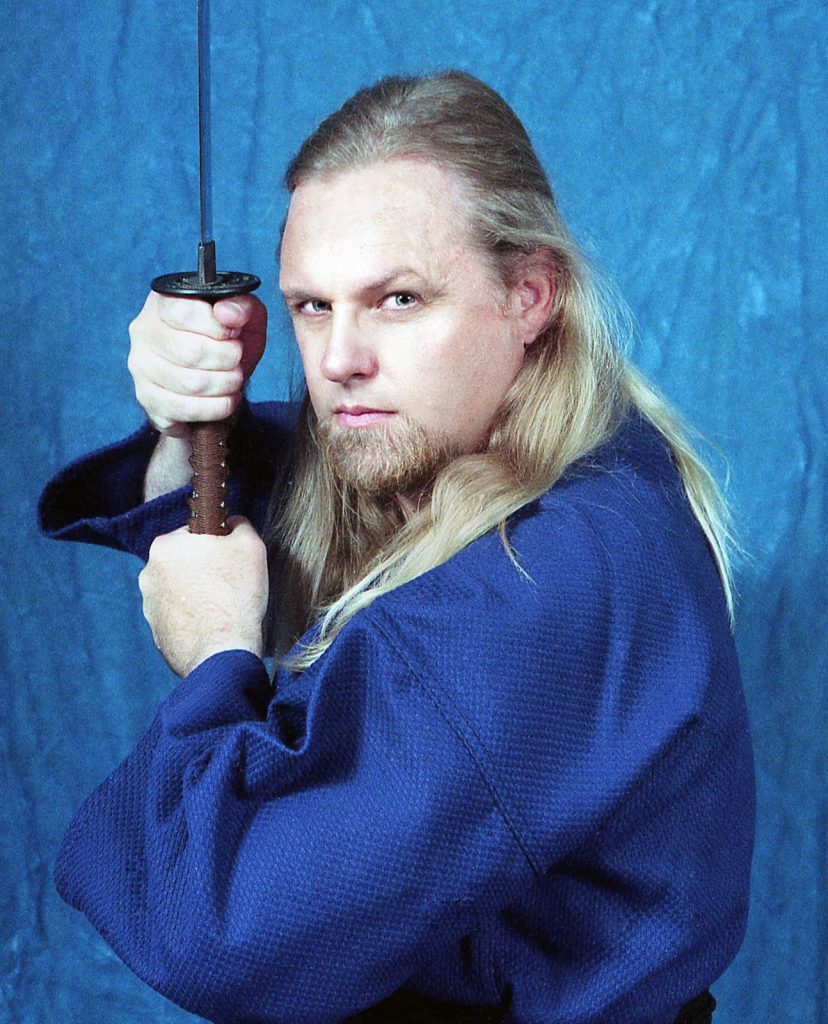
Throughout the 1980’s, while Shaw was securing his Graduate Degrees. He continually returned to various geographic locations in Asia to not only refine his physical and mental understanding of the Martial Arts and meditation. And also to personally researched extensive studies on Asian culture and history, as well.
Due to this fact, he often times find himself at odds with those who detail inaccurate accounts of the Martial Arts. Scott states, “The history of Martial Arts is continually inaccurately portrayed and this truly hurts the arts. So much of both the ancient and modern history I hear spoken of and see written about is completely wrong. People hear information from a second hand source and believe it to be true without researching it themselves.
Then, they become very angry when someone like myself attempts to present a true representation of the past. For the most part, history is researchable. And it does not denigrate an art in anyway to have its historic facts presented in their entirety. The modern Korean Martial arts were elementally influenced by the Japanese arts. And the ancient Japanese systems developed in no small part due to the influence of the Korean and later the Chinese system of self-defense.
So, it is an ongoing circle of constant interaction. This is nothing to hide or be ashamed of.”
History of Hapkido - Why Hapkido?
During his teenage years Shaw branched off from Hapkido to include Taekwondo and the source art of Hapkido, Aikijutsu into his studies. Though he possesses extensive experience in all three of these arts This is rivaled by few Americans. His primary discipline is on the further evolution of Hapkido. When questioned as to what maintains his focus on this art, he answers, “Hapkido is an expansive system of self defense where you truly come to understand the subtle elements of movement associated with the human body. Once the dynamics of human motion is understood, Hapkido then teaches you how to gain mastery over every action that an adversary unleashes. The art has thousands of movements and techniques, so there is always a new element to study, refine, and master.”
Due to Shaw’s basis in Hapkido, he is a firm believer in the fact that forcefully blocks should never be used as a first line of defense. That it is better to intercept a punch or a kick. He details, “When you intercept a forceful attack with a powerful block, the energy of force meeting force will often times injure the blocking element of your own body. In Hapkido, the primary form of defense is deflection. In Hapkido’s science of deflection you are not simply guiding your attacker’s punch or kick away from you, as is the case with Aikido. Instead, you deflect his offensive attack by using the force of his own expended energy.
You then guide him into the most appropriate positioning where a powerful counter strike or a throw can be initiated utilizing his own forward driven power. With this style of defense, you not only save your own energy but allow your opponent’s actions to dominate what type of counter attack you launch.”
History of Hapkido - Scott Shaw’s Brand of Hapkido
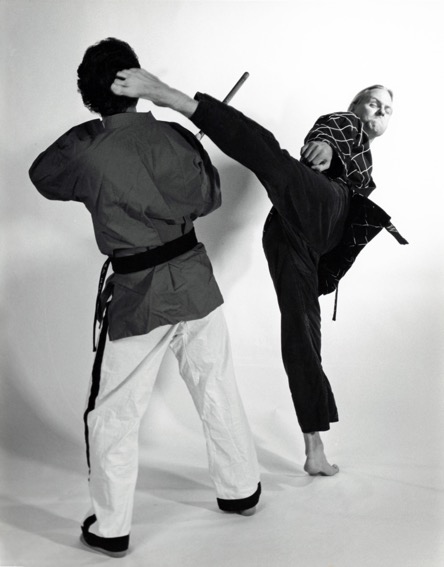
Hapkido is commonly defined by its advanced throwing techniques. Shaw has refined these applications to a new level of effectiveness, focusing his teachings upon the truly effective self-defense applications of the art.
He states, “For anyone who has viewed the techniques of the arts born out of Aikijutsu, such as Hapkido and Aikido, the throws are the most impressive part. And, on a demonstration level they are beautiful to watch. In a street confrontation, however, you are not going to be able to toss your opponent artistically through the air with such precision.
There is a saying among Aikijutsu practitioners in Japan, which loosely translates,
‘I would like to thank my training partner for allowing me to throw them.’ That’s very true.
So, I focus my style of Hapkido on techniques which are based in viable self defense applications which teaches the student to defend themselves and disable an attacking opponent in the most efficient way possible — even if it isn’t all that pretty."
Taekwondo
Though Shaw’s primary focus is on Hapkido he understands that on the world-wide level Taekwondo is a much more practiced art. He defines the reasoning for this, “You have to understand that in Korea Taekwondo is the National Sport. Every boy, and many girls, from junior high level onward, and often times earlier than that, are taught Taekwondo as part of their school curriculum.
After high school each Korean male must serve in the military. There, they are again indoctrinated into further Taekwondo training so arts like Hapkido and Tang Soo Do are generally only practiced by those Koreans who seek them out or by those individuals who are the children of the forefathers of these arts. As there are so many more Taekwondo students produced in Korea, the numbers just multiply as the numerous instructors move to other countries and take on their own students.”
Shaw doesn’t believe that one art is superior to the other. “As is the case with all Martial Arts, it’s solely the individual practitioner who defines the effectiveness of their system of self defense. I think we have all experienced those Martial Artists who are so insecure that they criticize other people and other forms of Martial Arts — claiming that their teacher is better, their style is superior, and that they could kick the butt of this person or that person if they had they chance. I mean, what a waste of time! There’s no need for that kind of mentality any more. Martial Arts should be a method to defend yourself only when it’s absolutely necessary — other that that, it should be seen as a method to focus your body, mind, and spirit.”
History of Hapkido - The Science of Ki
The ancient science of Ki is also an integral part of the Scott Shaw system of Hapkido. Though it has been overlooked by many modern practitioners of the Martial Arts, Shaw believes that this essential knowledge should be integrated into a systems of self-defense. “Using Ki does not mean that you possess the ability to touch a pressure point on a person’s body and they instantly fall over dead. That’s all in the movies and propagated by charlatans. What the conscious usage of Ki does teach the practitioner is how to instantly tap into superior mental and physical strength and to unleash that power to locations on an individual’s body which will hamper their ongoing assault in a confrontational situation.”
Many people doubt the existence of Ki. To reply to them Shaw says, “From modern science we learn that every element of the universe, from the smallest subatomic particle to the largest planet is pulsates with an energy. That energy is Ki. We, as human being, have the ability to consciously tap into it through precise control of our breath. Though it takes time and a lot of mental refinement, once one develops the ability to tap into Ki, they can then use it to not only heal and replenish their own body but to heal others, as well. Or, defend themselves, if the situation arises.”
History of Hapkido - Spirituality
Shaw always integrates the spiritual essence of the Martial Arts into his teaching, believing that, “Those who see the Martial Arts as solely a method to kick somebody’s butt are really basing their life on the most animalistic level of existence. Martial Arts trains your body to become acutely in tune with your mind. From this, you can raise your consciousness to a much more refined level of intuitive understanding than is possessed by the average individual. Fighting, though it is the bases of the Martial Arts, does not have to be its end result.”
History of Hapkido - Scott Shaw Today
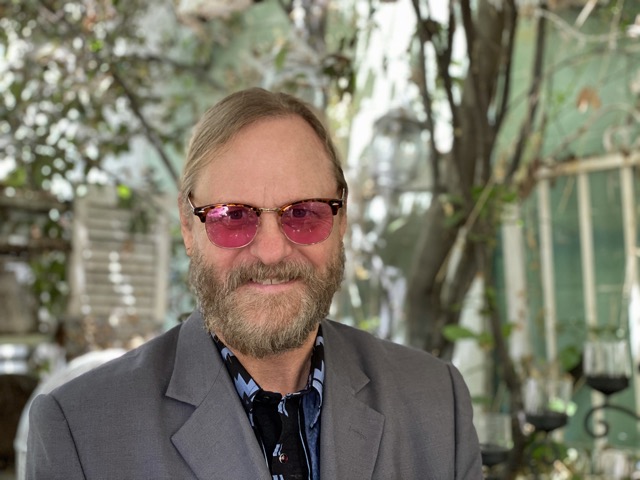
Today, we find Shaw possesses his typically non-stop personality, tempered with a jovial edge. He divides his time between writing, instructing a small group of advanced Martial Art students, leading meditation and Ki seminars, participating in film projects as a Producer, Director, and Actor, teaching film making courses at universities including U.C.L.A, and frequently traveling to Asia to document obscure aspects of Asian culture.
With his long list of accolades and publications Shaw is always quick with a smile and never willing to take himself too seriously. He says, “Anyone who believes they have mastered the Martial Arts is fooling themselves. Mastery means there is nothing left to learn. Life is a continual education.
The Martial Arts are a lifelong journey. If you close yourself off to new ideas you can never grow as a practitioner or a human being. Always remain open to new knowledge and new realizations.”
History of Hapkido - Contributions
Grand Masters Shaw's contribution to Hapkido makes this an important part of the History of Hapkido. Also important to note here. Grand Master Shaw was one of the original members of the World Budo Alliance back in the late 90's and early 2000. And this is one of the reasons he is listed her first on the list of influences. Here is a link to Grand Master Shaw's website.
Grand Master Shaw has been mocked and attacked over the years by martial in Hapkido. In my opinion this is PATHETIC and those who attack others are also pathetic. I see a lot in the martial arts world I do not like. But I am not going to try to make myself look bigger by calling them out.
I have not talked with Scott in years. But he is a kind, big hearted man, always willing to help. My life is better for having known him.
Grand Master John Pellegrini
Chon-Tu Kwan (Combat) Hapkido
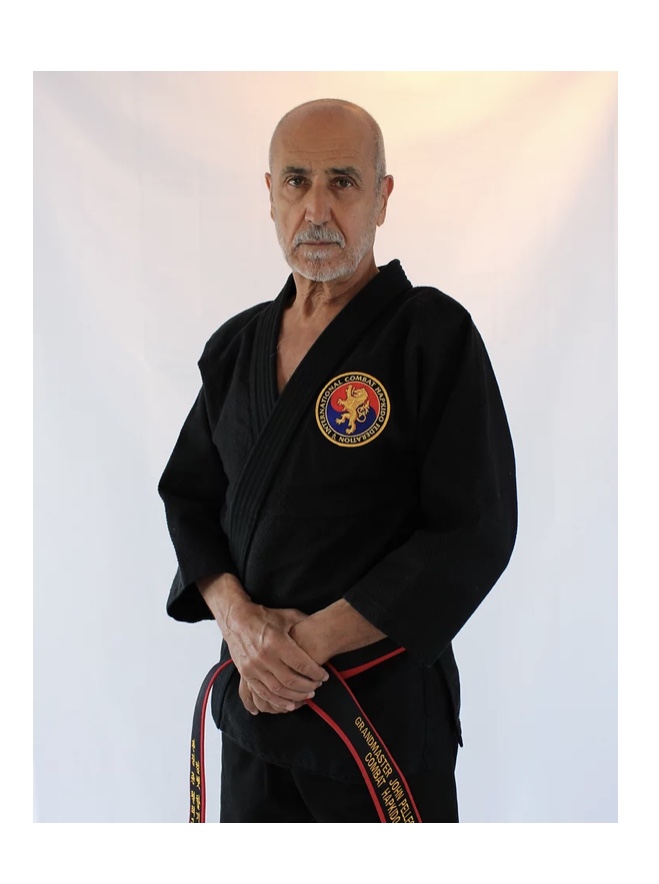
We cannot talk about the History of Hapkido without talking about GM Pellegrini.
Combat Hapkido (known in Korean as Chon-Tu Kwan Hapkido 전투관 합기도) is an eclectic modern Hapkido system founded by John Pellegrini in 1990.
Taking the next step in 1992 Pellegrini formed the International Combat Hapkido Federation (ICHF). Done as the official governing body of Combat Hapkido.
Later, in 1999, the ICHF was recognized by the Korea Kido Association and the World Kido Federation.
These are collectively known as the Kido Hae, as the Hapkido style Chon Tu Kwan Hapkido.
The World Kido Federation is recognized by the Government of South Korea.
Recognized as an organization that serves as a link between the official Martial Arts governing body of Korea and the rest of the world Martial Arts community.
Combat Hapkido
The founder of Combat Hapkido was very clear in his statement that he did not invent a new martial art. He stated "I have merely structured a new Self-Defense system based upon sound scientific principles and modern concepts. For this reason Combat Hapkido is also referred to as the "Science of Self-Defense." Combat Hapkido is a new interpretation and application of a selected body of Hapkido techniques.
The word "Combat" was added to Combat Hapkido to distinguish this system from Traditional Hapkido styles. And also to identify its focus as Self-Defense.
The style employs joint locks, pressure points, throws, hard strikes. And also low-lying kicks and trains practitioners to either counter or preemptively strike an imminent attack to defend one's self. In common with many Hapkido styles, it also emphasizes small circular motion, non-resisting movements. And control of an opponent through force redirection and varied movement and practitioners seek to gain advantage through footwork. And also distractive striking and body positioning to employ leverage.
I am not including Grand Master History of Hapkido John Pellegrini credentials in this history. And with his 50 years plus of experience they are vast. You can research those from his Combat Hapkido website.
Thank you
Thank you for reading the History of Hapkido. This is still as massive as it is far from complete. There are many great martial artists involved in Hapkido. However to recognize everyone would not be possible. There are men like Grand Master Booth, and my personal linage from Chung W Oh to name a few.
The researcher of the information Sensei Kara Borshuk is also a practitioner of Hapkido.
This article on the History of Hapkido will expand over time as more information comes to light. however the representation does work for the time being.
Thank you for your time and have a wonderful day! Keep Learning!
Vă mulțumesc pentru timpul acordat și o zi minunată! Continua sa inveti!
Al vostru în arte,
Mare Maestru Art Mason
